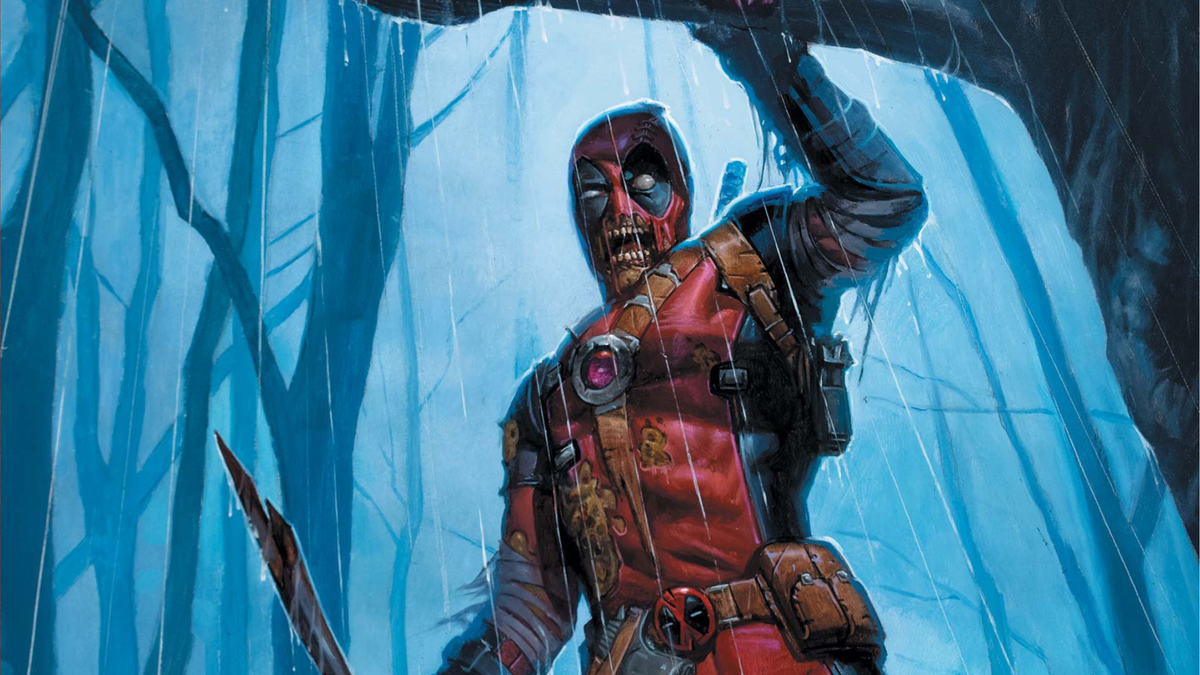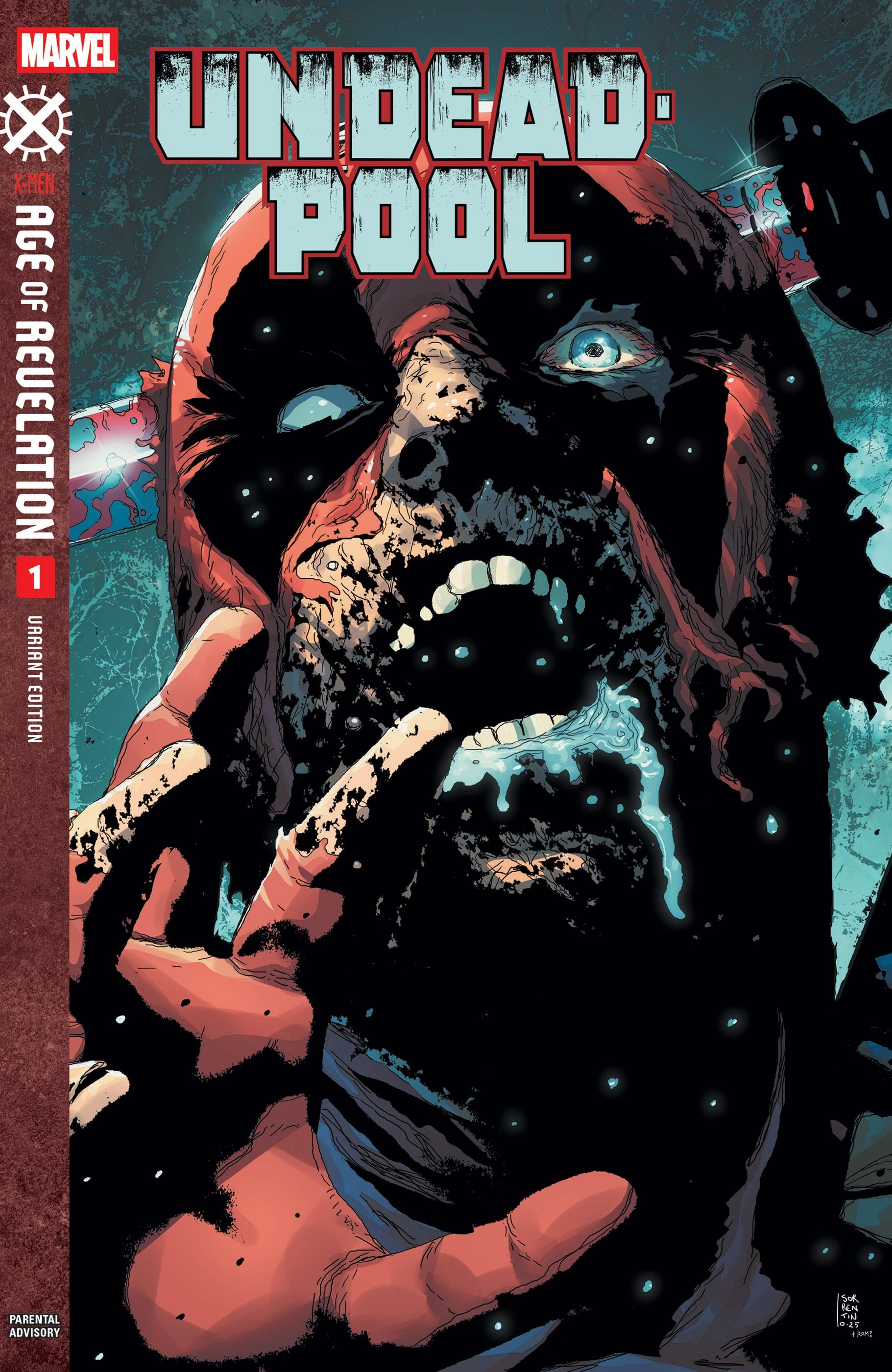
There are few comic book characters quite like Deadpool. For starters, how many fictional characters are not only completely aware that they’re fictional, but also have different styles of textboxes to represent the different voices in their head? I’d wager it’s a pretty short list. Even for those unfamiliar with that particular quirk of the character, there are undoubtedly two qualities that anyone familiar with Deadpool are aware of: his healing factor and his relentless, ridiculous mouth. X (10) years in the future, however, the Age of Revelation has twisted both into a fate as nightmarish for him as it is for his victims. More on that in a moment.
*Mild spoilers ahead for Undeapool #1*
Written by Tim Seeley, Undeadpool starts off like a post-apocalypse movie, which I suppose in many ways this is. If you’ve not read or watched our other reviews for books set in Marvel’s new Age of Revelation series —which you absolutely should— then let me catch you up real quick. 10 years ago (or X years, since what’s an X-Men event without that particular theme?) a gene bomb was detonated, spreading the X-virus, which in turn killed millions and turned the survivors into mutants. In the wake of that cataclysmic event a mutant named Doug Ramsey —formerly known as Cypher, now known as Revelation— took control of the affected areas, turning them into a mutant nation known as the Revelation Territories. Those who follow him —willingly or otherwise— become his seraphim or choristers. Those who don’t are stripped of their language abilities and reduced to babels.
Anyway, our story begins with a group of teenagers trying to escape the Revelation Territories. But as with any good —or, let’s face it, even bad— horror/apocalypse story, their journey is going to be anything but easy. Their car is already broken down on the first page, and when told it’ll be several days before replacement parts can be obtained they decide to abandon the car and continue on foot. Because that always goes well in these types of stories.

Before they make it too far, they’re attacked by a group of babels, who are revealed to be essentially mindless savages determined to kill these newcomers foolish enough to breach their territory. But these teenagers aren’t your typical “dumb kids doing everything they can to be killed in a horror movie” teens. They’re mutants. Not just that, but they’re mutants with a decent amount of skill when it comes to using their abilities in combat. They make quick work of the babels, followed by the type of revel you would expect from cocky kids who feel invincible. In their revels, though, they fail to realize the true danger awaiting them isn’t these mindless savages. Something far more dangerous and horrific lies in hiding within the area, as they’re about to learn to their chagrin.
You see, although Deadpool has a healing factor reminiscent of another beloved —albeit angrier— Canadian character, his ability was not the result of a natural mutation, but rather a government experiment. This means that he could be killed by the X-virus, though in his case he found himself suffering a fate arguably worse than death. His healing factor kept his body alive, but in a zombified state. His mind, meanwhile, remains fully conscious, though is seemingly now a prisoner in his rebellious body, forced to watch powerless as his undying form hunts and feeds upon its victims. Yeah, it’s a nightmarish fate, and one that he’s unlikely to escape anytime soon as he can’t seem to die.
Jumping back to our valiant band of teen mutants, they finally stop for the night in the ruins of an old summer camp. Two of them go off in search of something to eat, and I’m sure you can probably guess where this is going. The body formerly known as Deadpool kills one of them, and their nightmare begins.
Right out of the gate, this story has the makings of a fantastic horror story. The concept of a person trapped in their own head, helpless to stop themselves from committing unspeakable atrocities while also knowing there’s unlikely to be an end to their nightmare is absolutely terrifying. And we feel the true extent of Deadpool’s horror throughout the story as he narrates through an internal monologue nobody else will ever hear. To those unfortunate young mutants, he’s little more than a zombie relentlessly pursuing them to feast upon their flesh. To the reader, however, we’re presented with both sides of the horror story, making it hit all the harder.
As unique as this change to a familiar concept is, however, it isn’t flawless. Yes, it adds another layer of horror for readers to contend with, but it also makes it harder to care as much about these new characters. All we know about them is what Deadpool’s ongoing narration tells us, and while I doubt anyone is rooting for these young mutants to die, I personally found little reason to see them as anything more than expendable tools meant only to show the horrific thing Deadpool had become.

Carlos Magno’s artwork perfectly highlights the tonal shifts of the story. From the opening pages he presents us with an unmistakable post-apocalyptic world straight out of something like The Walking Dead. Broken down cars, burning buildings in the distance, and a general air of darkness fill the pages. Even without knowing the backstory to the Age of Revelation event, it’s clear that something horrific has happened here.
The book isn’t all doom and gloom, however, and Magno makes sure to provide some light in moments where things seem to be going right for the teens. This shift appears almost immediately after they ditch their broken-down car, with the quartet leaving behind the foreboding grays and blacks to literally walk towards the sun rising over a body of water. Color returns to the world, from the greens and reds of apple trees around them to the backgrounds of their battle with the babels. For a moment this feels less apocalyptic and more like a triumphant story of a young team of superheroes. The tone steadily shifts back to the darkness, however, as the zombie formerly known as Deadpool appears, reminding us exactly what kind of story this really is.
Although Undeadpool is part of the larger Age of Revelation event currently ongoing, it gratefully doesn’t bog itself down trying to connect itself too much into the larger narrative being told in other titles. Yes, there are references to what’s going on, but only insofar as to help set up what’s led us to this horrific moment. Beyond the necessary exposition, the story largely remains honed in on the narrower tale it’s trying to tell. Whether this will continue to be the case or not remains to be seen, but for the moment Undeadpool seems content to simply tell its nightmarish tale of an essentially undead Deadpool.
But for those perhaps thinking —or perhaps fearing— that this is just going to be another Marvel Zombies style story, the ending will quickly dispel that notion with two big reveals. One that presents a touch of hope to light the darkness of the story, and another that reveals that the horror awaiting us is far from over.
Undeadpool #1 is available now from Marvel Comics.
Undeadpool (2025) #1
Good
On the surface, Undeadpool #1 might appear to be little more than a Marvel Zombies retread, and for obvious reasons. However, I get the feeling this book is trying to be more than that, especially given the two big reveals at the end of the issue. It’s still too early to say for certain where this story is going, but as a standalone issue this book reads like a more unique zombie story, one in which we’re able to see every thought and emotion of its “monster.” There are predictable genre tropes, of course, but these seem to be intentionally used to misdirect the reader from the reveal at the end. Overall, Undeadpool #1 is a decent start to what could prove to be a tale as interesting as it is tragic.
Pros
- Deadpool’s continual narration adds a tragically unique touch to a familiar plotline
- Magno’s artwork perfectly highlights the shifting tone of the story
- Reveal at the end promises big things ahead
Cons
- Might come off as just a Marvel Zombies copy
- Using Deadpool as the primary POV makes it hard to care much about new characters
This review is based on a retail copy provided by the publisher.
